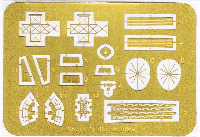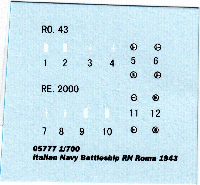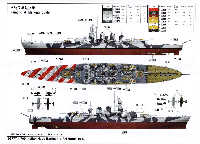| HISTORY |
|
|
The Vittorio Veneto class was the last class of battleships to be build by the Italian Navy- the Regia Marina. This class of battleships were designed to maximize the standards under the Washington Treaty, while meeting the operational requirements of the Italian Navy and the logistical limitations of Italian manufacturing. This lead to a class of ships said to be some of the most aesthetically pleasing capitol ships ever built. Armed with nine 381mm (15") guns in three triple turrets as the main battery, twelve 152mm (6") guns in four triple turrets as a single purpose secondary battery, and 12 90mm AA guns in stabilized mounts, six to each side amidships, these ships were also mostly well protected for their weight. One of the limitations accepted to keep the total tonnage down for the class was a limitation in range, since these ships were never intended to operate outside the Mediterranean Basin.
Of the four ships in the class built, Roma was the third; the first ship in the second group of two. After Littorio and Vittorio Veneto were found to be very wet at speed, Roma and Impero were designed with a raised bow. Roma also differed by having one anchor each to port and starboard; the other ships had one port and two to starboard.
Roma was launched on the 9 of June, 1940; one day before Italy entered the war. Roma was lost 9 September 1943, after being hit by two Fritz X German guided glide bombs; she quickly broke in two and sank, taking most of her crew with her.
|
| HULL AND DECK |
|
|
Molded in Trumpeter's standard grey upper and red lower hull, this kit also has a red waterline plate which fits snugly into the upper hull. There is also a
deck piece which covers the main deck, leaving the lower quarterdeck for a smaller part. Dimensionally, the hull looks pretty good. The upper hull is wider than the lower hull at the waterline, but the plate fits snugly and well. The upper hull does have a bit of flash running long the lower edge, but a swipe with a hobby knife or sandpaper should clear it up easily.
The distinctive armor belt is prominently on the upper hull, while the lower hull is less demonstrative with the bulge from the Pugliese underwater protection system. The plating detail fore and aft on the upper deck, while slightly overscale, looks good. The lower hull has the plate for paravane chains at the extreme bow, which is slightly bulbous like prototype. The stern of the lower hull is disappointing, however. The secondary rudders to not have flared skegs to fit into, and the keel appears a bit short. The usual Trumpeter heavy mold lines on the lower hull are present.
If a full hull model is desired, be prepared to work on the lower hull; the hull will need spacers to widen, sanding to remove the mold lines, putty work to fair in the rudders and touch up the keel.
|
|
 &nsbp &nsbp
 |
|
|
| SPRUE A |
|
This first sprue of Roma has a nicely done aircraft catapult, the primary rudder and the skegs and shafts for the screws. There are some other pieces and parts; the light AA platform for the main turrets, some delicate masts and yards, an aircraft handling crane and motor pinnace.
|
 |
|
|
| SPRUE B X4 |
|
Trumpeter packed all sorts of good details on this sprue. B has all armaments; the main 381mm battery, the secondary surface 152mm batteries, 90mm AA guns, light AA, starshell guns- they're all here. The secondary rudders are also here, and a good selection of life rafts, cable reels and searchlights.
This kit had the 381mm barrels both with and without bloomers. The barrels themselves are poorly tapered with an exaggerated muzzle flare. The twin Breda AA look good for this scale, as do the three turret styles. The raised rivet detail on the 90mm turrets is nicely done, and not too overscale. The main gun turrets and the secondary look very well done as well.
|
 |
|
|
| SPRUE D X2 |
|
This smaller sprue has various details for around Roma; the preponderance of the ship's boats, the propellers, ladders from the main deck to the stern, signalling lamps, etc.
|
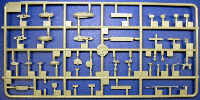 |
|
|
| SPRUE E X2 |
|
E is the smallest of the Roma sprues in this kit, with the secondary battery directors, anchors and other fill-in parts.
|
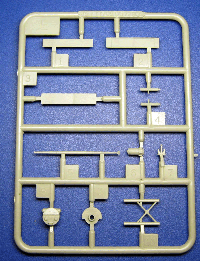 |
|
|
| SPRUE F |
|
This sprue is mostly parts to make the bridge and conning tower structure. The charthouse and platform are molded as one piece, with the mass of AA directors molded in as well. The undersides of the various platforms have very lightly molded girder details.
The other primary part on this sprue is the stern deck piece. Like the main deck, it has good details and nicely executed staggered planking. The arced rail for swinging the aircraft launching catapult is in place on the deck- the slight overhand to port and starboard are delicate.
|
 |
|
|
| SPRUE G |
|
Sprue G has the 01 level superstructure deck and bulkhead. The deck has molded in locators for the stacks and other details, and also the cradles for the ship's boats are molded in place. This sprue also includes the pieces to make the two funnels, and some parts to finish out the bridge and conning tower, and the nameplate
|
 |
|
|
| RO.43 |
|
This kit of Roma carries parts for two different types of aircraft, the IMAM Ro.43 and the Reggiane Re.2000. The Ro.43 floatplane sprue has parts to make up to two aircraft, which was the maximum carried by a Vittorio Veneto class. These moribund reconnaissance biplanes were ill-suited for most uses required of them, but they continued in service well into the war.
|
 |
|
|
| RE-2000 |
|
This second of the two aircraft types included, the Reggiane Re.2000 was designed as an interceptor. Interestingly, the Re.2000 was not a floatplane, but rather this
aircraft was a carrier version of a land-based fighter. As Italy did not have an aircraft carrier, the Regia Marina experimented with launching them from cruisers and battleships. As the RM would rarely operate far from land, these aircraft could be catapult launched from sea on a one-way trip; perform their mission, and return to a airfield ashore.
This sprue comes with parts to make up to three of this planes. The Vittorio Veneto's were equipped to carry three, but never actually fielded more than one.
|
 |
|
|


